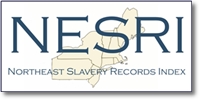When campus officials and faculty members model and normalize slavery, this sends an important educational message to students, who as alumni bring these values and norms back to their home communities. Thus, slavery on campus can promote slavery in distant communities. This is particularly true when the campuses are educating future ministers and religious leaders, who then model and espouse slavery to their congregations and home communities.
The Northeast Slavery Records Index (NESRI) is has indexed many records of enslavement across the northeast, and has begun to match slavery records with officials and students of universities and colleges, and developing online reports of the records we index. We include local records of enslavement by college officials and regional records by students in their home communities. The project focuses on universities and colleges founded before the official establishment of the United States.
Important notes: This report includes the records in the database as of the moment the report is generated. Our research continues and additional records are continuously added to the database and sometimes corrections and updates are made. Therefore, reliance on a saved or printed version of a report is not recommended.
It is also important to understand the limitations of this project. One limitation is that most slavery in the northeast is not consistently documented, particularly in the 1700s and early 1800s. So the project understates the numbers of officials and students who were enslavers. Furthermore, there are many instances where there are multiple name matches but we cannot determine that the “Peter Smith” who graduated is the same person as any of the “Peter Smith” enslavers. Campus-based researchers may be able to provide enrollment records to connect the dots.
University and College Records
This report provides three tables of records documenting slavery by college officials and by students after they graduate. While the officials may have practiced slavery on or near to campus, we document student enslavers after they graduate, and many of these students become influential community leaders as ministers or governmental officials.
Table One: College Officials: The first table displays slaveholding records of officials associated with the colleges and universities. These include college presidents, administrators, faculty members, trustees and donors. Most of these records are based on campus projects documenting campus-based slavery.
We have not yet separated donors and faculty from the general list of officials because the numbers of individuals are not yet large enough to warrant separate tables.
Students and Alumni: Table Two displays records of students, typically alumni of colleges and universities. Records are grouped for each enslaver. The “Enslaved” records identify people being enslaved. The “College” records identify college registrations of student enrollments and graduations of the future enslavers. The “Clergy” records identify the clerical histories of divinity students who during their careers, after graduation, modeled slavery in multiple communities and churches. These records illustrate legacies of slavery beyond the campus, across several states and many communities. You can click on the “View Details” button for any record. The clerical records include a listing of all of the communities and churches served by the enslaver.
Enslaved People: Table Three presents the names of people enslaved by the college officials and students identified in the above two tables. Many enslaved people have multiple NESRI records because several records may document the enslavement at different times. For example, a sale may document enslavement by two enslavers.
Note that in most cases, the enslaved people do not live at the campus. Most students eventually reside in distant communities and states, spreading norms and values of enslavement far from the university campus.
Clergy: Table Four identifies members of the clergy, for various religions, who had official roles or who graduated from the college or university in the report. Important resources that document the universities attended by colonial clergy are Colonial Clergy of New England and Colonial Clergy of the Middle Colonies.
The historical effects of clerical slavery are significant. Prestigious universities model slavery as part of the education of divinity students, and the students go forth to distant communities and serve as ministers, modeling and legitimizing slavery to their congregations.
ABOUT NESRI
NESRI is an online searchable compilation of records that identify individual enslaved persons and enslavers in the states of New York, Maine, New Hampshire, Vermont, Massachusetts, Rhode Island, Connecticut and New Jersey. NESRI indexes census records, slave trade transactions, cemetery records, birth certifications, manumissions, ship inventories, newspaper accounts, private narratives, legal documents and many other sources. The goal is to deepen the understanding of slavery in the northeast United States by bringing together information that until now has been largely disconnected and difficult to access. NESRI has indexed almost 70,000 records relating to slavery, most naming the enslaved people and/or their enslavers.
To see what NESRI does, the most direct and simple approach is to click on Find Community or Locality Records. Anyone can identify a place like the name of a Town or County or an entire state, and see a customized report of the enslavement records for the selected locality. For colleges and universities, we uses this page to present tables of officials, students and enslaved people.



